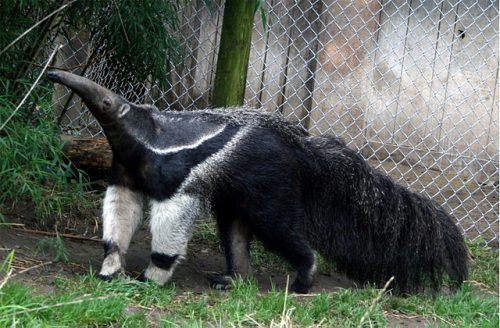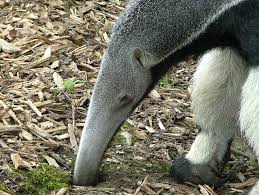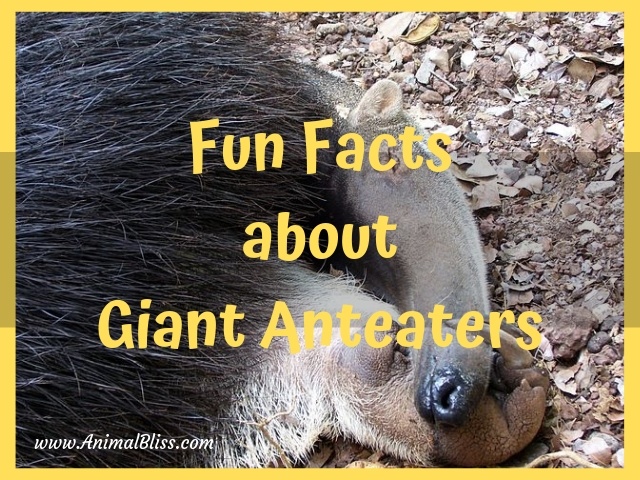Fun Facts About Giant Anteaters
Here are some fun facts about Giant Anteaters that I’ll bet you didn’t know. Such as, did you know it has a 2-foot long tongue? No? Read on then, for some more cool stuff.
Fun Facts About Giant Anteaters
- The giant anteater’s tongue is typically two feet long — 24 inches (60 cm)! No other mammal has a tongue as long relative to its body size. The tongue is sticky and has spikes, and anteaters can flick their tongues more than 150 times per minute to suck up bugs without getting bit or stung.
- Its tubular snout, which ends in its tiny mouth opening and nostrils, takes up most of its head.
- Its eyes and ears are relatively small.
- It has poor eyesight, but its sense of smell is 40 times more sensitive than that of humans.
- Giant anteaters can live around 16 years in captivity.
- Giant anteaters have the lowest body temperature of any mammal. Because bugs don’t provide Anteaters with a ton of energy, they have slow metabolisms and a body temperature of only 90.86 degrees Fahrenheit.

♥♥♥
Giant Anteaters – Unique Tongues
The anteater has no teeth and is capable of very limited jaw movement. Jaw depression creates an oral opening large enough for the slender tongue to flick out. The tongue is covered in backward-curving papillae and coated in thick, sticky saliva secreted from its enlarged salivary glands, which allows the anteater to collect insects with it.
During feeding, the tongue moves in and out around 160 times per minute (nearly three times per second). When fully extended, the tongue can reach 45 cm (18 in); longer than the length of the skull.
They just mash ants against the roof of their mouth and eat more than 35,000 ants and termites every day.
♥♥♥
Giant Anteaters – Toes and Claws
Giant anteaters have five toes on each foot, which includes four claws and a smaller vestigial toe. Three of these claws are more prominent than the others. The anteater walks on its front knuckles (similar to the African apes) because its claws are so big and sharp and this helps to keep them out of the way.

♥♥♥
Giant Anteaters – Reproduction and Motherhood
Giant anteaters carry their babies on their backs to make themselves look bigger and protect themselves from predators. Infant giant anteaters spend up to the first two years of their lives with their mothers and spend most of their first year clinging to her back.
Giant anteaters can mate all year round. Male and female pairs are known to feed at the same insect nest. While mating, the female lies on her side as the male crouches over her. A couple may stay together for up to three days and mate several times during that period. Gestation lasts around 190 days and ends with the birth of a single pup, which typically weighs around 3 pounds (1.4 kg). Females give birth standing upright.
Pups are born with eyes closed and begin to open them after six days. The young communicate with their mothers with sharp whistles and use their tongues during nursing. After three months, the pup begins to eat solid food and is fully weaned by ten months at which time the bond decreases between mother and offspring. Young anteaters usually become independent by nine or ten months and become sexually mature in 2.5 to 4 years.

♥♥♥
More Fun Facts About Giant Anteaters
- The giant anteater, also known as the ant bear, is a large insectivorous mammal native to Central and South America. It is one of four living species of anteaters and is classified with sloths in the order Pilosa.
- This species is mostly terrestrial, in contrast to other living anteaters and sloths, which are arboreal or semi-arboreal.
- The giant anteater can be found in multiple habitats, including grassland and rainforest. It forages in open areas and rests in more forested habitats.
- It feeds primarily on ants and termites, using its front claws to dig them up and its long, sticky tongue to collect them.
- Though giant anteaters live in overlapping home ranges, they are mostly solitary except during mother-offspring relationships, aggressive interactions between males, and when mating.
- Mother anteaters carry their offspring on their backs until weaning them.
Sloths are one of the anteater’s closest relatives.
Giant Anteaters – Endangered Species
The giant anteater is listed as Vulnerable by the International Union for Conservation of Nature. It has been extirpated from some parts of its former range. Threats to its survival include habitat destruction and poaching for fur and bushmeat, though some anteaters inhabit protected areas.
Giant anteaters have been around for 25 million years!
SOURCE: Wikipedia / giant anteater
RELATED:
Sloths: Fun Facts About Sloths That Will Make Fall in Love with Them
*
Fun Facts About Giant Anteaters That Make Them Awesome, #anteaters #giantAnteaters #endangeredSpecies #endangeredMammals Click To Tweet
MY QUESTION FOR YOU TODAY: Isn’t nature marvelous? Have you ever seen an anteater or a sloth? Aren’t they the coolest?
Please leave your comment below.
(It’s just sexy!)

As always, thank you for taking the time to visit my blog.
PEACE
DISCLOSURE: Animal Bliss is a participant in the Amazon Services LLC Associates Program, an affiliate advertising program designed to provide a means for us to earn fees by linking to Amazon.com and affiliated sites.
(In other words, we’ll get a very small (teeny tiny) commission from purchases made through links on this website.)
So, go on … Don’t be shy!
Buy Something BIG and Expensive!
Buy a Jaguar. Or a Ferrari.
Thank you!
😀
[amazon_link asins=’1620311720,B072KP7K42,1618934147,1421424673,1596439254,1561457582′ template=’ProductGrid’ store=’animblis-20′ marketplace=’US’ link_id=’484015f8-0d5b-4968-929d-c48c0f983206′]
😆
- Mindful Travel With Your Dog This Holiday Season - December 23, 2019
- A-Z of Australia’s Endangered Wildlife - December 20, 2019
- Teaching Your Kids How to Walk the Dog Safely - December 2, 2019


Hi Jeanne,
These pictures say a thousand words! I love the one where the anteater is scratching himself!
I didn’t know much about them until I came on over here. How amazing are they, especially when they pair up and have pups!
The animal kingdom never ceases to amaze me and I thank you for sharing this.
-Donna
Awesome animal Jeannie, thank you! I had no idea that they had such a low body temperature, 90.8 degrees! Now I know what mammal has the lowest body temp of us all! Keep it up sweetie! Jon the Birdman
Well I’ve learned something new!
Aren’t they sweet!
lol it makes me fall in love with Anteaters. Thank you for sharing!
Funnily enough, I actually knew all of this! I volunteered at a zoo for 2 years, putting in over 800 hours. I learned a lot about all of the animals at the SF Zoo, and they had a giant anteater! I had so much fun learning so many fun facts, and sharing them with zoo visitors!
I actually have not seen an anteater before. They are very interesting! I didn’t know their tongues was 2 feet long!
Hi Jeanne,
this animals are really amazing .
I like them ,especially the babies on the back 🙂
Would be interesting to know ,if they would find enough
food here .
Thank you for sharing 🙂
I was fixin’ to say the reminded me of sloths when the sloth picture appeared. My daughter LOVES them (sloths) and we hope to see some in the wild when we get to the jungle part of our Ecuador trip.